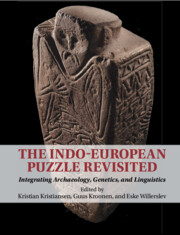Book contents
- The Indo-European Puzzle Revisited
- The Indo-European Puzzle Revisited
- Copyright page
- Contents
- Figures
- Tables
- Contributors
- Preface
- Introduction
- Part I Early Indo-European and the Origin of Pastoralism
- Part II Migratory Processes and Linguistic Dispersals between Yamnaya and the Corded Ware
- 5 The Corded Ware Complex in Europe in Light of Current Archaeogenetic and Environmental Evidence
- 6 Emergent Properties of the Corded Ware Culture: An Information Approach
- 7 Linguistic Phylogenetics and Words for Metals in Indo‑European
- 8 Word Mining: Metal Names and the Indo-European Dispersal
- Part III The Cultural and Linguistic Significance of Bell Beakers along the Atlantic Fringe
- Part IV The Bronze Age Chariot and Wool Horizons
- Part V Kinship Systems, Marriage, Fosterage, Free, and Unfree
- Concluding Reflections
- Index
- References
7 - Linguistic Phylogenetics and Words for Metals in Indo‑European
from Part II - Migratory Processes and Linguistic Dispersals between Yamnaya and the Corded Ware
Published online by Cambridge University Press: 29 April 2023
- The Indo-European Puzzle Revisited
- The Indo-European Puzzle Revisited
- Copyright page
- Contents
- Figures
- Tables
- Contributors
- Preface
- Introduction
- Part I Early Indo-European and the Origin of Pastoralism
- Part II Migratory Processes and Linguistic Dispersals between Yamnaya and the Corded Ware
- 5 The Corded Ware Complex in Europe in Light of Current Archaeogenetic and Environmental Evidence
- 6 Emergent Properties of the Corded Ware Culture: An Information Approach
- 7 Linguistic Phylogenetics and Words for Metals in Indo‑European
- 8 Word Mining: Metal Names and the Indo-European Dispersal
- Part III The Cultural and Linguistic Significance of Bell Beakers along the Atlantic Fringe
- Part IV The Bronze Age Chariot and Wool Horizons
- Part V Kinship Systems, Marriage, Fosterage, Free, and Unfree
- Concluding Reflections
- Index
- References
Summary
The prehistoric spread of Indo-European languages across Europe and Asia was a process with dramatic consequences that are still being felt in the modern world.1 Today around half the world’s population speak an Indo-European language; some of the most widely spoken are Spanish, English, Hindi, Portuguese, Bengali, and Russian. The Indo-European languages are grouped into ten major subgroups, or branches: Italic, Celtic, Germanic, Greek, Armenian, Albanian, Indo-Iranian, and Balto-Slavic, as well as Anatolian and Tocharian (both extinct). These branches all descend from a common ancestor, Proto-Indo-European.
- Type
- Chapter
- Information
- The Indo-European Puzzle RevisitedIntegrating Archaeology, Genetics, and Linguistics, pp. 93 - 104Publisher: Cambridge University PressPrint publication year: 2023



